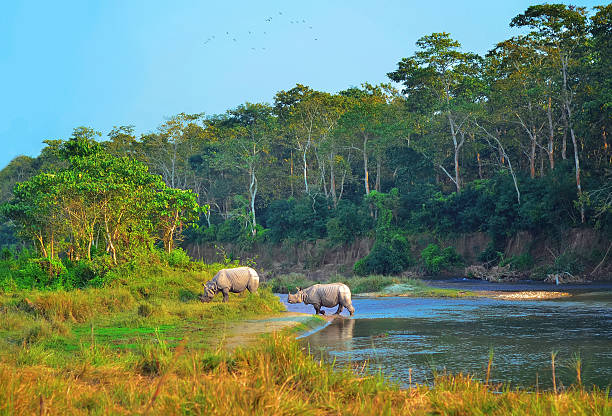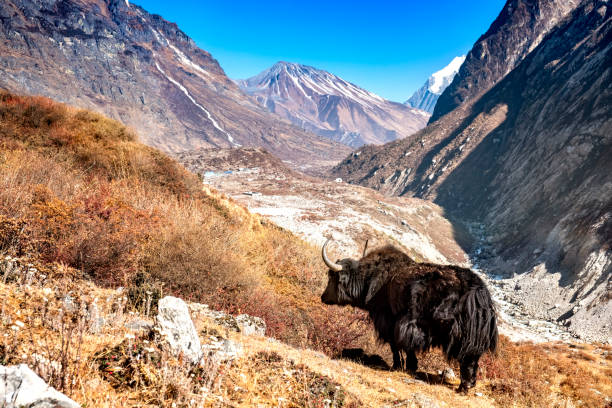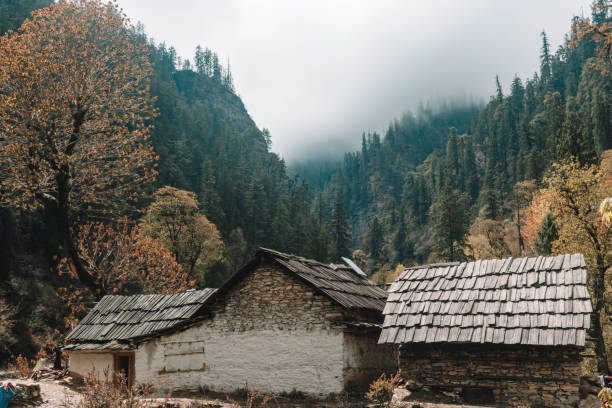Nepal does not fail to surprise the world with its wonders. From being a country of cultural diversity and heavenly landscapes to obscure history, this country offers it all. Moreover, this country is home to some of the best flora and fauna in the world. The natural gift demands special care, and Nepal has provided it with some of the best national parks in the world.
So, let’s take a glance at Nepal’s national parks.
12 National Parks in Nepal
Nepal has a total of 12 national parks across the country. It might seem much, but it is pretty remarkable, considering the size of the country. These 12 national parks have some distinct features that make them one of a kind.
So, let’s look at some of the best national parks in this country.
Chitwan National Park

Chitwan National Park proves the nation's dedication to protecting its abundant biodiversity. Chitwan, one of Asia's most well-known national parks, attracts nature enthusiasts and animal lovers with its astounding variety of flora and fauna. It is the most visited national park in Nepal.
Chitwan National Park, situated in the subtropical lowlands of southern Nepal, covers an incredible 952 square kilometers and is home to thick forests, grasslands, and wetlands. The park, founded in 1973, was recognized as a UNESCO World Heritage site in 1984 for its significant contribution to biodiversity preservation.
This place is home to rare and exotic animals like the One-Horned Rhinoceros, Royal Bengal Tiger, Asian Elephant, Sloth Bear, Marsh Mugger Crocodile, Gharial (Fish-Eating Crocodile), Spotted Deer (Chital), Hog Deer, Sambar Deer, Wild Boar, Bengal Fox, and Hanuman Langur.
Moreover, you can find other animals like the Indian Pangolin, Indian Python, Indian Cobra, Common Krait, Monitor Lizard, Assam Roofed Turtle, and other species of Turtles and Tortoises.
Best time to visit: February – April
Bardiya National Park
Bardiya National Park, located in Nepal's untouched and remote western area, is an emblem of abundant biodiversity. Bardiya, one of Nepal's largest and least-polluted protected regions, attracts both environment and wildlife lovers with its astounding variety of plants and animals.
Bardiya National Park, with its roughly 968 square kilometers of varied terrain, is a sanctuary for animals. The region's extensive grasslands, deep woodlands, and flowing rivers create a flourishing environment that supports a remarkable diversity of plant and animal species.
Royal Bengal Tiger, One-horned Rhino, Mugger Crocodile, Gangetic Dolphin, and Golden Jackal call this place their home. Likewise, more than 300 bird species, including the Bengal florican, Sarus crane, smaller florican, great hornbill, osprey, and black-necked stork, are said to reside in the park.
Best time to visit: October to March
Sagarmatha National Park

Sagarmatha National Park is a realm of unmatched beauty and intrigue in eastern Nepal's remote regions. This unique national park, located within the Himalayan mountain range, captures the hearts and minds of those who enter its boundaries.
Sagarmatha National Park is a magnificent treasure trove of natural beauties, spanning over 1,148 square kilometers of rough terrain. Mount Everest, often called Sagarmatha locally, is the park's focal point, standing at an impressive 8,848 meters (29,029 feet) in height.
Climbers worldwide are attracted to Everest's majestic majesty and its mesmerizing aura to reach its challenging summit.
Numerous endangered species, including the snow leopard, red panda, and Himalayan black bear, can be found in the Sagarmatha National Park. Musk deer, Himalayan tahr, and Himalayan wolves are other species in the park. Numerous birds are to be found, including the Himalayan monal, snow partridge, and yellow-billed chough.
Best time to visit: April-May and September – December
Makalu Barun National Park
A wilderness that captures the Himalayas in all their natural beauty can be found in eastern Nepal. Welcome to Makalu National Park, an enchanted haven of natural splendor that draws both daring adventurers and nature lovers.
Makalu National Park spans 1,500 square kilometers and has spectacular vistas and unmatched natural beauties. Mount Makalu, a towering giant rising to a height of 8,485 meters (27,838 feet), lies at the center of the landscape.
Makalu emits an atmosphere of grandeur, motivating mountaineers and explorers to push their limits against its challenging slopes. A spectacular amphitheater of snow-capped peaks surrounds it.
Makalu Barun, which is close to the mountains, is home to several rare and endangered species. There have been reports of sightings of Himalayan tahrs, red pandas, and snow leopards. The national park also has Musk deer, Himalayan black bears, and Clouded leopards.
Likewise, the Assamese macaque and the Grey langur are two of the many primates that live in the park.
Over 400 different species of birds can be found in Makalu Barun, one of Nepal's underappreciated national parks. The Himalayan monal, satyr tragopan, snow pigeon, yellow-billed chough, and various eagle, falcon, and vulture species are among the birds that may be found there.
Best time to visit: March – April or October – November
Langtang National Park

There is a treasure hidden in Nepal's stunning surroundings that perfectly captures the tranquil beauty of the Himalayas. Greetings from Langtang National Park, a haven of serene valleys, majestic peaks, and thriving biodiversity.
Langtang National Park, which covers an area of 1,710 square kilometers, possesses a seductive charm for individuals seeking solace amid nature.
Langtang Lirung and Dorje Lakpa are two impressive snow-capped peaks that stand as sentinels, reminding us of the splendor of the Himalayan range with their towering presence.
The flora and fauna of Langtang are as diversified as those found in Sagarmatha and Makalu Barun. The red panda, Himalayan black bear, musk deer, and snow leopard all call the national park home, as they do in most alpine regions. More than 250 bird species, including the Himalayan monal, blood pheasant, and snow partridge, can be found here.
The Himalayan larch, among other threatened plant species, can be found in the Langtang region, along with rhododendron, oak, and bamboo.
Additionally, the national park features several glaciers, rivers that are significant freshwater sources, and high-altitude lakes.
Best time to visit: March – April or October – December
Khaptad National Park
Khaptad National Park is a pristine and little-known gem hidden in Nepal's remote west. This charming national park offers a calm haven for those seeking comfort in nature's embrace, far from the busy people and tucked in the peaceful Himalayas.
Khaptad National Park, which covers an area of around 225 square kilometers, is a sanctuary of breathtaking scenery. Its varied landscape comprises rolling meadows, lush forests, alpine pastures, and pristine lakes.
The biodiversity of the park is very impressive. There are several different wildlife species that reside here, such as musk deer, Himalayan black bears, leopards, and langurs.
Likewise, over 270 birds have been documented in the park, including the vibrant Himalayan monal, pheasants, and eagles, which will excite birdwatchers. An ecosystem thriving in harmony due to the abundance of flora and wildlife provides a window into the delicate balance of nature.
Best time to visit: October – December
Shey Phoksundo National Park
Shey Phoksundo National Park, which is tucked away amid the wild and ethereal landscapes of western Nepal, calls with a seductive attraction. Here, a pristine environment and a profoundly spiritual atmosphere combine to create a world of tranquility and enchantment.
Shey Phoksundo National Park, which spans an area of about 3,555 square kilometers, is a tribute to the Himalayas' unbridled might and breathtaking grandeur. The captivating Phoksundo Lake, one of Nepal's deepest lakes, is at its center.
Shey Phoksundo National Park is renowned for its gorgeous blue waters, which appear to reflect the sky above. Snow-capped mountains and rocky cliffs complement the lake's ethereal beauty, creating a picture-perfect, calm, uplifting setting.
Shey Phoksundo National Park serves as a shelter for unique and endangered wildlife and is an attraction for nature's beauty. The existence of snow leopards, Himalayan blue sheep, and musk deer in the park's remote areas serves as a reminder of the tenuous balance in this harsh environment.
The variety of birds adorn the skies, such as the vibrant Himalayan monal and the secretive Tibetan snowcock, can be found here.
Best time to visit: April-May or October-November
Koshi Tappu Wildlife Reserve
secret oasis awaits wildlife enthusiasts, and environment lovers tucked away in the lush floodplains of the mighty Koshi River. Welcome to Koshi Tappu National Park, a wetland wonderland that demonstrates the extraordinary biodiversity of Nepal's Terai area.
Koshi Tappu Wildlife Reserve covers a vast area of 175 square kilometers and is a shelter for wildlife, migratory birds, and the unspoiled vistas that characterise the area.
Known as a birdwatcher's paradise, Koshi Tappu National Park draws a variety of bird species from all over the world. Numerous migratory birds that use this area as a wintering habitat are among the more than 500 species identified here.
Here, Elegant waterfowl, graceful egrets and herons, colourful kingfishers, and elusive birds of prey create a beautiful tapestry of feathers and melodies. Moreover, birdwatchers will enjoy seeing endangered species like the Bengal Florican and the secretive Swamp Francolin.
Although birds are the main attraction, the park is also home to diverse fauna. An endangered wild water buffalo known as the "Arna" seeks shelter within the park's confines.
The gorgeous aquatic animal, the Gangetic dolphin, gently swims through the river's currents. The occasional sighting of a fisher cat or a rare Indian rhinoceros adds spice to your travel through the park. Likewise, you might sight a Marsh mugger crocodile lazing in the sun.
Best time to visit: October through May
In conclusion, Nepal's national parks are true gems that provide a paradise for those who enjoy the outdoors and animals. Each national park offers a distinct and breathtaking experience, from the wild beauty of Chitwan National Park to the pristine landscapes of Sagarmatha National Park.
The parks mentioned above are a destination for discovery, adventure, and spiritual renewal because of the magnificence of the Himalayas, the richness of flora and animals, and the rich cultural heritage of the area's inhabitants.
Nepal's national parks provide a lifetime trip, whether you go on exhilarating hikes, see rare species, get involved in local customs, or simply take in the tranquillity of these natural treasures.
Parsa Wildlife Reserve
For those who enjoy the outdoors and wildlife, there is a hidden treasure in the Terai region of Nepal. Welcome to the Parsa Wildlife Reserve, a mesmerising refuge brimming with untamed beauty and diverse wildlife.
Parsa wildlife reserve spans a vast 499 square kilometre area and provides a window into the natural treasures that make the Terai region exceptional.
The Parsa Wildlife Reserve is recognized for having a diverse range of wildlife and serving as a habitat for various species. The reserve is home to one of Nepal's most significant populations of elephants, so you might see the magnificent Asian elephant here.
Within these protected areas, the critically endangered one-horned rhinoceros, a well-known representation of Nepal's wildlife conservation efforts, finds sanctuary. The elusive Bengal tiger, sloth bear, wild boar, deer, and several reptile and bird species, are among the other animals that make the reserve their home.
The reserve's nearly 300 species-strong avifauna will enthrall birdwatchers. Many bird species, such as the colorful Indian peafowl, the endangered Bengal florican, and the great hornbill, find their ideal habitat in the grasslands, marshes, and riverine areas.
Best time to visit: February – April
Shuklaphanta Wildlife Reserve
A secret sanctuary that captures the spirit of unspoiled wildness is buried in Nepal's southwest plains. Welcome to Shuklaphanta Wildlife Reserve, a paradise for lovers of both wildlife and the outdoors. This outstanding reserve spans a vast 305 square kilometers and beautifully displays Nepal's Terai region's unspoiled beauty and diverse wildlife.
Shuklaphanta Wildlife Reserve is a paradise for environment lovers thanks to its illustrious wildlife population.
The reserve is home to Nepal's largest herd of "barasingha," or endangered swamp deer. The endangered Bengal tiger, Asian elephant, leopard, wild hog, and different deer and antelope species are some of the other notable inhabitants of the reserve.
With over 350 kinds of birds documented here, the reserve will enthrall birdwatchers with its avian diversity. Numerous birds, especially rare and migratory species, are drawn to the reserve's wetlands and water features.
The resonant cries of the Sarus crane, the graceful flight of the Asian openbill stork, and the bright kingfisher's plumage all combine to produce a symphony of hues and sounds that satisfies the senses.
Best time to visit- September-December and February to the end of May
Rara National Park

A secret gem of remarkable beauty and tranquillity is buried in Nepal's far-flung northwest, Rara National Park, a beautiful refuge that perfectly encapsulates unspoiled nature.
Rara National Park, which spans an area of 106 square kilometres, is home to the glittering Rara Lake, the largest lake in Nepal and a brilliant gem in the untamed Himalayan terrain.
Known for its exceptional biodiversity, Rara National Park is a perfect habitat for a wide variety of flora and fauna that thrive in its distinct habitats. A wide range of animals, including Himalayan black bears, musk deer, red pandas, and elusive snow leopards, call the park's deep woodlands home.
The park is home to many bird species, including the colourful Himalayan Monal, the elusive Blood Pheasant, and various eagles and vultures soaring over the peaks. Birdwatchers will be delighted by this.
Best time to visit: March-May or October – December
Annapurna National Park
The majestic Annapurna National Park in Nepal's Himalayas beckons outdoor enthusiasts and environment lovers with its unmatched beauty and grandeur. This spectacular sanctuary, which spans large stretches of rocky terrain, is a monument to the amazing force of nature.
This renowned national park spans 7,629 square kilometres and is the entryway to stunning scenery, a wide variety of species, and an unmatched trekking experience.
The park is a haven for many plants and animals that thrive in its many ecosystems. There is a plethora of plant life along the pathways, including rhododendron forests, bamboo groves, and fragrant plants. Rhododendrons blossom in all their splendour in the spring, bringing a riot of colour to the hillsides.
The park is also home to numerous bird species and rare and endangered wildlife like the elusive snow leopard, Himalayan tahr, and musk deer. Both lovers of the outdoors and wildlife will find bliss here.
Best time to visit: October and November or April and May


